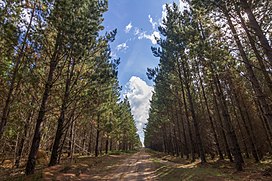Belanglo State Forest
| Belanglo State Forest | |
|---|---|
 | |
| Geography | |
| Location | New South Wales, Southern Highlands, Australia |
| Coordinates | 34°31′52″S 150°15′36″E / 34.531146°S 150.260049°E |
| Administration | |
| Established | 1919 |
| Governing body | [1] |
| Ecology | |
| Dominant tree species | Pine |

Belanglo State Forest is a planted forest, of mainly pine but some native forestry around the edges, in the Australian state of New South Wales; its total area is about 3,800 hectares.[2] The Belanglo State Forest is located south of Berrima in the Southern Highlands, three kilometres west of the Hume Highway between Sydney and Canberra. The forest is owned by the New South Wales Government and contains some of the earliest pine plantings in the state. The first radiata pines were planted in this area in 1919.[3] The public has free access to the forest; it features two to four wheel drive tracks, creek crossings, and forest camping. It is popular among recreational trail bike riders.
History[]
Murders[]
In 1992 and 1993, seven skeletons were found in the forest, in what was described by media as the backpacker murders and was considered to be the work of a serial killer.[4][5] Eventually, Ivan Milat, an Australian of Croatian descent was convicted of the murders in 1996 and sentenced to life imprisonment.[6]
On 22 November 2010, three teenagers (including one related to Milat)[7] were arrested on suspicion of connection with the discovery of a murdered male in the forest, following a tip-off.[8] David Auchterlonie was celebrating his 17th birthday on 20 November; Mathew Milat, 17, and Cohen Klein, 18 had planned for over a week to lure Auchterlonie to his death. A third person, Chase Day, 18 whose charges were later withdrawn by the DPP[9] went to police midday 21 November to report the murder.[10]
Other deaths[]
On 29 August 2010, trail bike riders discovered a human skeleton in the forest. Media reports at first linked the killing to Milat, but later forensic work disproved this theory as the remains were left there after he was sent to prison.[11] On 21 October 2015, the bones were identified as the body of Karlie Pearce-Stevenson, aged 22, from Alice Springs, Northern Territory. The body of Pearce-Stevenson's daughter, Khandalyce Pearce, aged 2, was found in a suitcase near Wynarka, South Australia, on 14 July 2015.[12]
References[]
- ^ "Belanglo State Forest". Forestry Corporation.
- ^ "Game and Feral Animal Control Act 2002" (PDF). p. 3037. Archived from the original (PDF) on 26 March 2012.
- ^ "PROCLAMATION—"FORESTRY ACT, 1916."". Government Gazette of the State of New South Wales. No. 215. New South Wales, Australia. 29 August 1919. p. 4744 – via National Library of Australia.
- ^ Lennon, Troy (19 September 2017). "Twenty five years ago the first victims of Backpacker Killer Ivan Milat were found in Belanglo Forest". The Daily Telegraph. Retrieved 25 March 2019.
- ^ "Case 109: Belanglo (Part 1)". Casefile: True Crime Podcast. 23 March 2019. Retrieved 10 June 2019.
- ^ Walker, Frank (23 May 2004). "Milat's brother claims police still treating him as murder suspect". The Sydney Morning Herald. Retrieved 25 March 2019.
- ^ Minus, Jodie (22 November 2010). "Relative of Ivan Milat charged over Belanglo forest killing". The Australian. Retrieved 22 November 2010.
- ^ "Case 109: Belanglo (Part 5)". Casefile: True Crime Podcast. 20 April 2019. Retrieved 10 June 2019.
- ^ "Someone's going to die: Belanglo teenager". The Australian. 25 October 2011. Archived from the original on 25 October 2011. Retrieved 21 April 2012.
- ^ "Milat's relative charged with allegedly killing teen David Auchterlonie on his birthday". Herald Sun. 23 November 2010. Retrieved 23 November 2010.
- ^ "Belanglo bones belong to teenage girl: police". ABC News. 15 September 2010. Retrieved 22 October 2015.
- ^ "Detectives link Wynarka girl's bones in suitcase to 'Angel' bones in Belanglo". The Daily Telegraph. 21 October 2015. Retrieved 22 October 2015.
- New South Wales state forests
- New South Wales geography stubs
